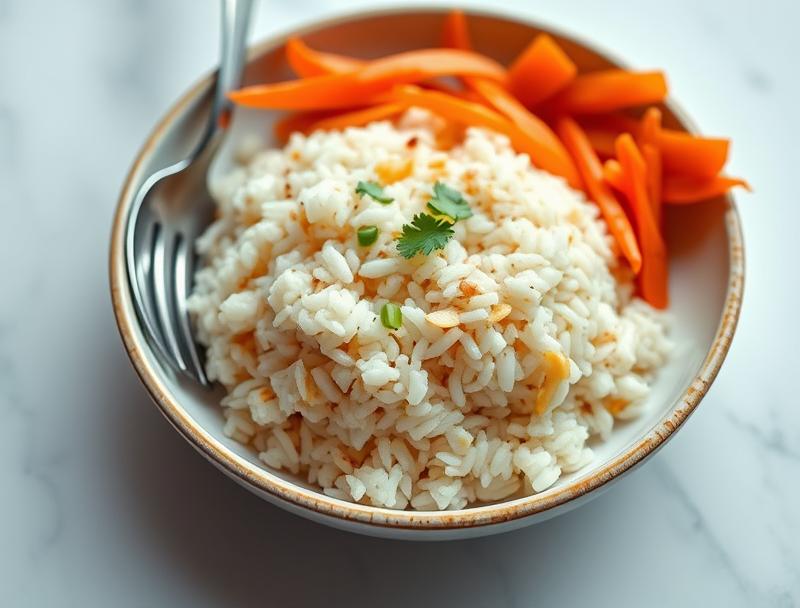How to Cook Rice
Introduction
Cooking rice is an art that combines ease, flavor, and creativity, all using everyday ingredients that are readily available in most kitchens. Whether you’re a seasoned chef or a beginner in the culinary world, mastering the technique of cooking rice is a fundamental skill that will elevate your dishes from simple to spectacular. With its versatility in both savory and sweet recipes, rice is a staple that can be transformed into a multitude of delicious meals with just a few tweaks in ingredients and cooking methods. In this article, we’ll delve into the world of rice cooking, exploring the why, the how, and the endless possibilities that this humble grain offers.
Why This Works
- Flavor balance and ingredient accessibility make cooking rice a universally appealing task, as it can be flavored and seasoned in countless ways to suit any taste preference.
- Ease of preparation is another significant advantage, as cooking rice requires minimal effort and can be accomplished with basic kitchen equipment, making it accessible to cooks of all skill levels.
- Impressive results with minimal effort are what make cooking rice so rewarding, as even the simplest of rice dishes can be presented in a way that’s both appetizing and satisfying.
Ingredients
- 1 cup of uncooked white or brown rice
- 2 cups of water
- 1 tablespoon of olive oil (optional)
- Salt, to taste
- Optional: herbs, spices, or other seasonings of your choice
Instructions
- Step 1: Begin by rinsing the rice in a fine mesh strainer under cold running water. This step helps remove excess starch, resulting in better textured rice.
- Step 2: In a medium saucepan, combine the rinsed rice and water. Add olive oil and salt if using. The general ratio for cooking rice is 1 cup of rice to 2 cups of water, but this can vary slightly depending on the type of rice and personal preference.
- Step 3: Place the saucepan over high heat and bring the water to a boil. Once boiling, reduce the heat to low, cover the saucepan with a tight-fitting lid, and simmer for about 15-20 minutes, or until all the water has been absorbed and the rice is tender.
- Step 4: Remove the saucepan from the heat and let it stand, covered, for 5 minutes. This step is crucial as it allows the rice to steam and become fluffy. After 5 minutes, remove the lid and fluff the rice with a fork to separate the grains.
Handy Tips
- Always use the right water ratio for the type of rice you’re cooking, as this affects the final texture and flavor. Brown rice, for example, requires a bit more water than white rice.
- Don’t overcrowd the saucepan, as this can lead to uneven cooking and mushy rice. Cook rice in batches if necessary.
- For added flavor, you can use broth instead of water or add herbs and spices to the rice as it cooks.
Heat Control
Heat control is crucial when cooking rice. Bringing the water to a boil and then reducing the heat to a simmer helps prevent the rice from cooking too quickly on the outside before it’s fully cooked on the inside. The ideal temperature for simmering rice is low, around 180°F to 190°F, which helps in absorbing the water slowly and evenly.
Crunch Factor
The desired texture of cooked rice is typically fluffy and separate, not crunchy. However, if you’re aiming for a crispy element in your rice dish, such as in fried rice or rice cakes, you can achieve this by drying cooked rice thoroughly before frying it in a bit of oil until it’s crispy and golden.
Pro Kitchen Tricks
- Use a rice cooker for perfectly cooked rice every time, as it automatically adjusts the heat and timing for different types of rice.
- For better flavor, sauté onions, garlic, or other aromatics in olive oil before adding the rice and water for a more complex taste profile.
- Experiment with different types of rice, such as jasmine, basmati, or wild rice, each offering unique flavors and textures to your dishes.
Storage Tips
- Cooked rice can be stored in the refrigerator for up to 3 days or frozen for up to 3 months. It’s best to cool the rice to room temperature before refrigerating or freezing to prevent moisture buildup.
- Reheat cooked rice by adding a bit of water or broth and heating it over low heat, stirring frequently, until the rice is warmed through and fluffy again.
- Use airtight containers to store cooked rice, keeping it fresh and protected from other flavors in the refrigerator or freezer.
Gift Packaging Ideas
While cooked rice itself might not be the most conventional gift, flavored rice mixes or gourmet rice varieties can be beautifully packaged in decorative jars or bags and given as a thoughtful gift to foodies or cooking enthusiasts. Add a ribbon and a recipe card for a personalized touch.
Flavor Variations
- Different spices: Try adding cumin for a Mexican flair, curry powder for an Indian twist, or paprika for a smoky flavor.
- Creative toppings: Add fresh herbs like parsley or cilantro, toasted nuts for crunch, or dried fruits for sweetness to your cooked rice.
- Ingredient swaps: Use coconut milk instead of water for a creamy and rich rice dish, or add grated vegetables like carrots or zucchini for added nutrition and flavor.
Troubleshooting
- Texture problems: If your rice turns out mushy, it might be overcooked. If it’s undercooked, it will be hard and crunchy. Adjust your cooking time and water ratio accordingly.
- Ingredient replacements: If you’re using a different type of rice, adjust the water ratio and cooking time as needed. Some types of rice, like brown rice, require more water and longer cooking times.
- Over/undercooking signs: Check the rice frequently towards the end of the cooking time. If it’s still hard, it needs more time. If it’s mushy or all the water has been absorbed and it’s still not tender, it might be overcooked.
FAQs
- Can I freeze cooked rice? Yes, cooked rice can be frozen for up to 3 months. It’s best to cool it to room temperature first and then freeze it in airtight containers or freezer bags.
- Is cooked rice gluten-free? Yes, plain cooked rice is gluten-free, making it a great option for those with gluten intolerance or sensitivity. However, be cautious of cross-contamination if cooking for someone with celiac disease.
- Can I double the recipe? Yes, you can easily double or triple the recipe for cooking rice, just remember to use a larger saucepan and adjust the cooking time slightly as more rice and water will take a bit longer to cook.
Conclusion
Cooking rice is a fundamental cooking skill that, once mastered, opens doors to a world of culinary possibilities. Whether you’re making a simple side dish, a flavorful pilaf, or a hearty stew, rice is a versatile ingredient that can elevate any meal. With the tips, tricks, and variations outlined in this article, you’re well on your way to becoming a rice cooking expert. So, don’t be afraid to experiment, try new recipes, and share your favorite rice dishes with friends and family. Happy cooking!

